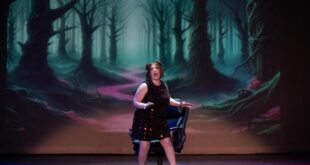Heartbeat Opera is known for adventurous productions. Their realization of Fidelio pitches Beethoven’s prison drama into the cauldron of America’s 21st-century racial reckoning, with stunning results.
Beethoven and the U.S. Prison-Industrial Complex
It doesn’t actually take much adaptation to shift this story to the present-day USA. Florestan becomes Stan (tenor Curtis Bannister, in glorious voice), an imprisoned Black activist being slowly starved by grudge-holding prison warden Pizarro (Corey McKern) and guarded by sympathetic C.O. Roc (Derrell Acon). Stymied by bureaucracy, Stan’s faithful wife Leah (a superb Kelly Griffin) infiltrates the prison as a guard and seeks to locate and free her husband.
Director Ethan Heard’s adaptation smartly modernizes the gender tropes of the original. Leah adopts a new persona, Lee, but doesn’t have to disguise herself as a man, since we know (see Orange is the New Black, for example) that our system doesn’t limit corrections personnel to those of the prisoners’ sex. And there’s no weirdness about Roc’s daughter Marcy falling for Lee, or, for that matter, for Roc’s unquestioning acceptance of his daughter’s sexual preference.
Soprano Victoria Lawal is beautifully adept at making Marcy’s arias emblematic of her character. Indeed the whole cast melds superb singing with fine acting, led by Griffin’s Leah and Acon’s Roc as the story’s dual moral centers.
The powerful cast, video contributions from prison choirs, and a score brilliantly transcribed for a small ensemble by Daniel Schlosberg make this Fidelio truly captivating.
Schlosberg conducted from the piano an ensemble of seven: two pianos, percussion, two cellos and two French horns. Cellos and horns both can sound very musical over extremely wide ranges; maybe that’s why he chose them. In any case the sound was orchestrally enveloping.
Prison Choirs and the “Prisoners’ Chorus”
Uniquely to this production, the “Prisoners’ Chorus” is sung by men’s and women’s prison choirs, recorded on visits to U.S. prisons. As we watch video and still shots of the choirs, the live band accompanies the recorded voices in a feat of synchronization. The effect was almost overwhelming – I can’t recall ever being more moved during an opera – ineffable music touching the nightmare of our prison-industrial complex with grace, if only for a short time.
With its newly written dialogue, including modern references (i.e. Martin Luther King Jr. Day), the show plays somewhat like a play with music or a Broadway musical. At the same time, operatic pacing counteracts that effect.

Reid Thompson’s set design economically uses fencing and ladders to evoke the levels of the prison where almost all the action takes place. But the spellbinding staging of (Flore)Stan’s first appearance needs no props. This is an extraordinarily powerful sequence. Stan is on the ground for the entire length of his arias. Bannister’s titanium voice seems at first to clash with the character’s abject condition; quickly we understand it as the mettle of his inner state. Lulled somewhat by the first half of the drama, with the homey, upbeat discomfort of Roc’s twinkling matchmaking and Marcy and Lee’s guardedly developing relationship, we’re not prepared for the revelation of Stan’s condition, his solitary howl. It’s a marvel of stagecraft.
Fidelio‘s happy ending becomes ambiguous (at best) in this version. That seems fitting for a production that’s commenting on an endemic societal problem rather than (merely) relating the fates of a few fictional individuals. Beethoven was as engaged in the sociopolitical traumas of his time as much as we are in ours. Maybe that’s why his only opera, like the rest of his music, continues to speak to us through the centuries.
Heartbeat Opera’s Fidelio played at the Metropolitan Museum of Art in New York City Feb. 10–13, 2022.
 Blogcritics The critical lens on today's culture & entertainment
Blogcritics The critical lens on today's culture & entertainment




